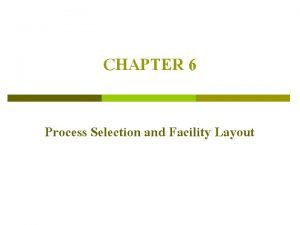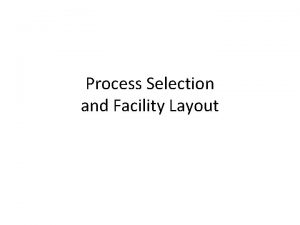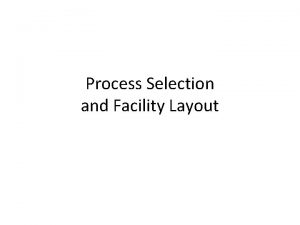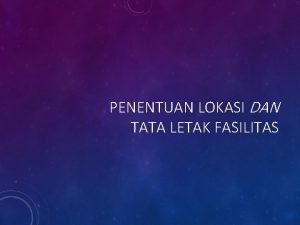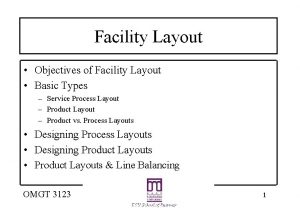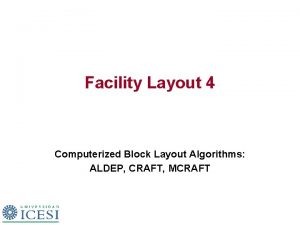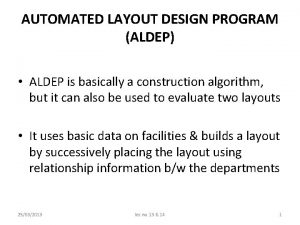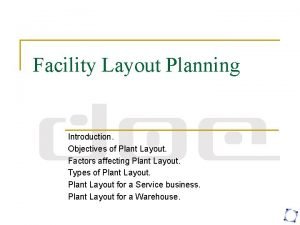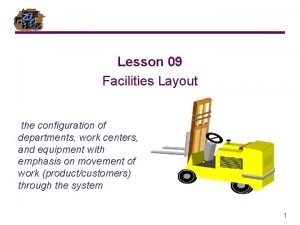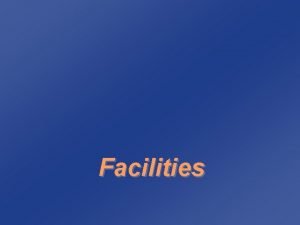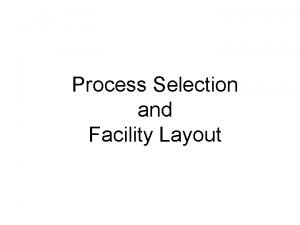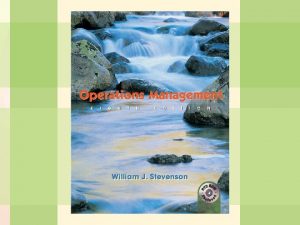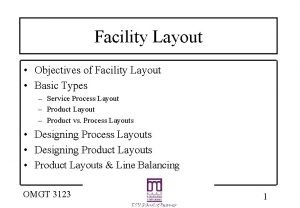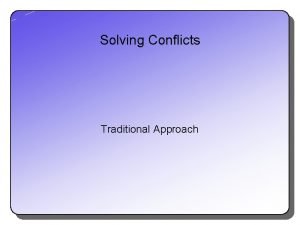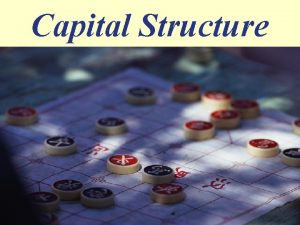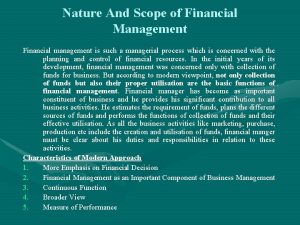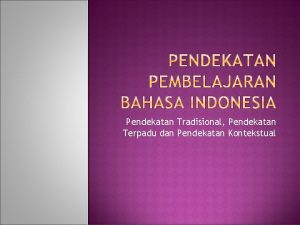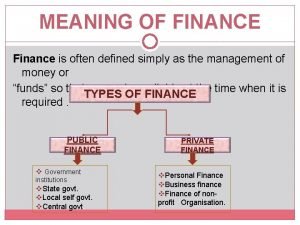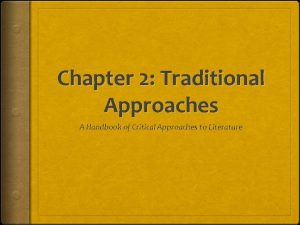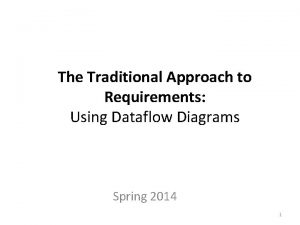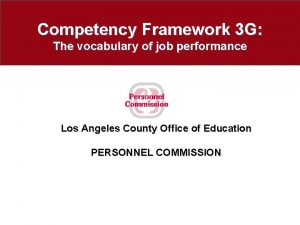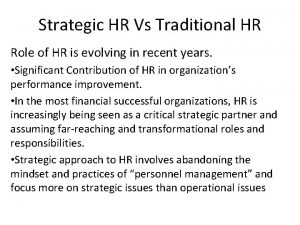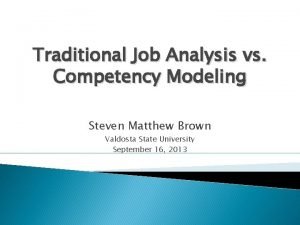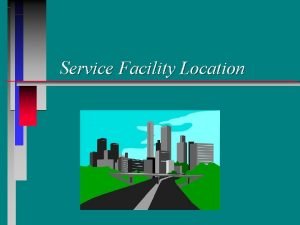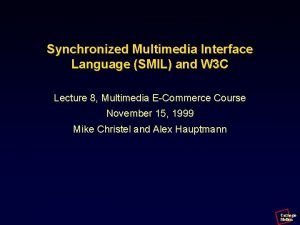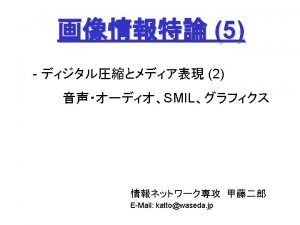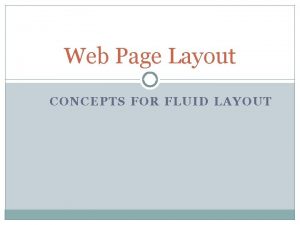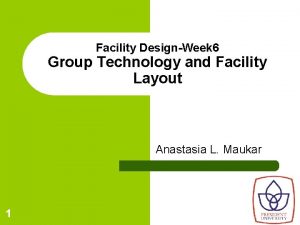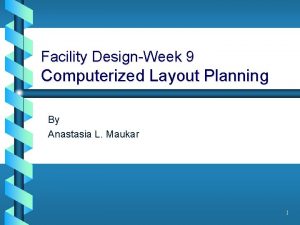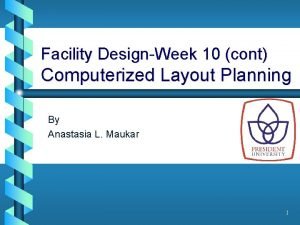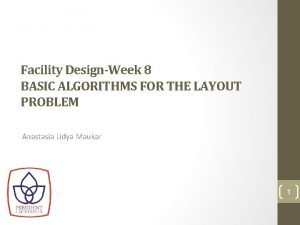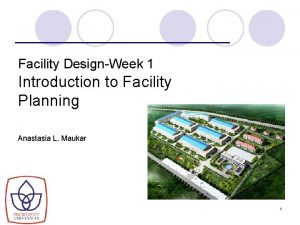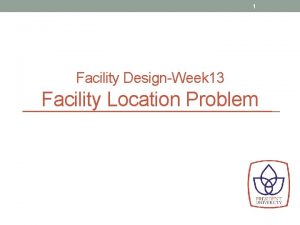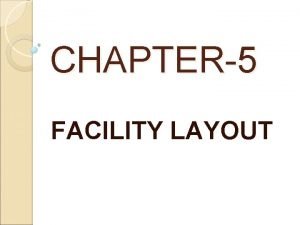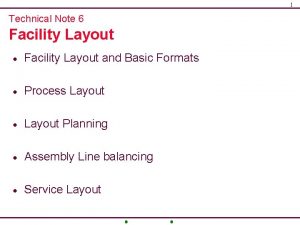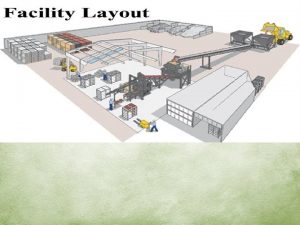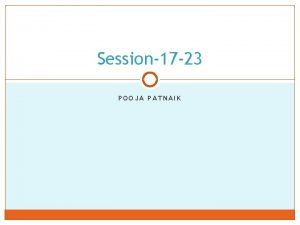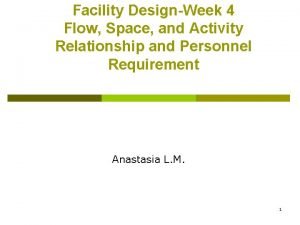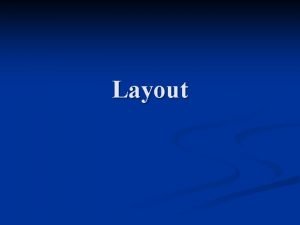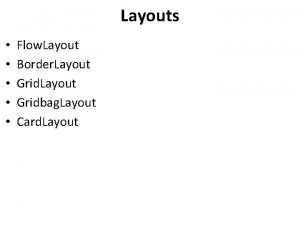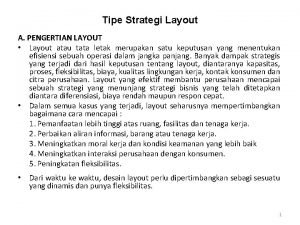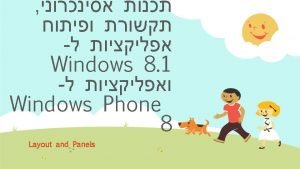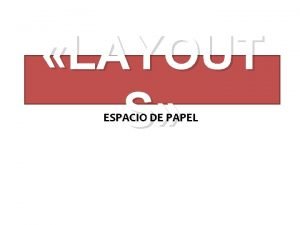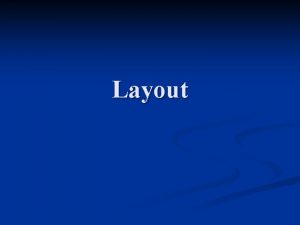Facility DesignWeek 3 Traditional Approach for Facility Layout












































- Slides: 44

Facility Design-Week 3 Traditional Approach for Facility Layout: Systematics Layout Planning Anastasia L. M. 1

Facility Layout p p A Layout problem may be to n determine the location for a new machine, n develop a new layout for an existing production plant, n develop a layout for a new production plant, n etc. A Layout problem may arises due to n changes in the design of a product, n addition or deletion of a product, n change in the demand of a product, n changes in the design of the process, n addition or deletion of a process, n replacement of equipment, n etc. 2

Objectives of Facility Layout p Minimize investment in equipment. p Minimize production time. p Minimize material handling cost. p Maximize utilization of space. p Maintain flexibility of arrangement and operation. p Provide safety and comfort to employees. 3

Sequential Approach vs Integrated Approach Sequential Approach : Product Design Process Design Facility Layout Material Handling System Design Production Planning 4

Sequential Approach vs Integrated Approach : Impressive results in cost, quality, productivity, sales, customer satisfaction, delivery time, inventory levels, space + handling requirements, building size, etc. Product Design Concurrent Engineering Process Design Terms of product, process, scheduling and facility design planners work with marketing, purchasing, etc. Personnel address the design process in an integrated way. Layout Design + Material Handling System Design Schedule Design 5

Facility Layout Procedures p Naddler’s Ideal System Approach (1961) p Immer’s Basic Steps (1950) p Apple’s Plant Layout Procedure (1977) p Reed’s Plant Layout Procedure (1961) p Muther’s Systematic Layout Planning (1961) 6

Systematic Layout Planning Phase I - Determination of the location of the area where departments are to be laid out p Phase II - Establishing the general overall layout p Phase III - Establishing detailed layout plans p Phase IV - Installing the selected layout p 7

Systematic Layout Planning ANALYZE Input Data and Activities 2. Activity Relationships 1. Flow of materials 3. Relationship Chart SEARCH 4. Space Requirements 5. Space Available 6. Space Relationship Diagram 7. Modifying Considerations 8. Practical Limitations SELECT 9. Develop Layout Alternatives 10. Evaluation Source: John S. Usher class notes 8

9

SLP 10

Systematic Layout Planning p p p P Product: Types of products to be produced What Q Quantity: Volume of each part type How Much R Routing: Operation sequence for each part type How S Services: Support services, locker rooms, inspection stations, and so on With What T Timing: When are the part types to be produced ? What machines will be used during this time period? When 11

Sample relationship diagram 12

Systematic Layout Planning Procedure 1. Relationships 1. 2. 3. 4. 3. Adjustments 1 Collection of Input Data Flow of Materials 2 Activity Relationships 3 Modifying Considerations. Practical Limitations. Evaluation & Final Selection. Relationship Diagrams 2. Space 1. 2. 3. Space Requirements Space Available Space Relationship Diagrams 13

Information Gathering Information about product, process and schedule is required. The major effect of product design decisions is felt by the process designer, i. e. , the material used to make a part will influence processing decisions. Design for automation programs have been developed that consider the impact of the design of the product on the assembly process. 14

Information Gathering Their primary thrusts are (1) dimensional reduction, (2) parts elimination, and (3) parts standardization. For (1), the cost of assembly is reduced if it occurs in a single dimension. The complexity of programming a robot increases geometrically with the number of assembly dimensions. For (2), if more complex parts can be produced, the number of parts can be reduced. Schedule design decisions tell us how much to produce and when to produce. From the market forecast, the production demand is determined and decisions about the production rate are made. 15

Information Gathering Information about product : - Photographs about the product - “Exploded” drawings - Engineering drawings of individual parts - Parts list - Bill of materials (structure of product) - Assembly chart 16

Information Gathering Information about process : • Route sheet (equipment and operation times) • Precedence Diagram (prerequisite assembly steps before new assembly step) • Operation process chart (processing operations, assembly operations, and inspections) 17

Information Gathering Information about schedule : • Production rate • Product mix • Market forecast (it is better to work with tomorrow’s data than today’s data) • Gantt charts 18

Information Gathering The information about Product Design and Process Design as an input for SLP have been discussed in week 2. 19

Flow Analysis and Activity Analysis p Flow of material analysis is related to quantitative analysis; to analyse the movement between departments/operational activities p Activity analysis is related to qualitative factors that affect the determination of a facility/depatment location should be placed. 20

From – To Chart p A chart is used for Quantitative Measurement from material movements 21

From-To Chart Example From To A B C D E F G H A Total 0 B 20 C 45 D 30 E 5 5 20 45 70 65 5 45 20 25 G 5 20 H 5 25 F 100 70 70 100 70 I Total I 70 25 50 75 75 30 60 25 45 30 100 75 75 60 620 22 22

From – To Chart (cont’) Forward Distance from diagonal 1 x 260 = 260 Backward Distance from diagonal 2 x 10 = 20 2 x 130 = 260 2 x 70 = 280 3 x 130 = 390 2 x 3 x 0 = 0 4 x 15 = 60 2 x 4 x 5 = 40 5 x 0 = 0 2 x 5 x 0 = 0 6 x 0 = 0 2 x 6 x 0 = 0 Total = 970 Total = 340 Total moment = 1. 310 23

Activity Relationship Chart p Suatu metode utk merencanakan & menganalisis keterkaitan antara setiap kelompok kegiatan yg saling berkaitan p Jenis-jenis keterkaitan dapat terjadi: n n n Between 2 production processes Between production process and service activity, or other activities. Between 2 service activities. 24

ARC (cont’) Closeness codes are: Code Color A Merah Definition/closeness rating Absolutely necessary E Jingga Especially Important I Hijau Important O Biru Ordinary Important U Uncolored Unimportant X Coklat Undesirable 25

Relationship Diagramming: Example Production Offices Stockroom Shipping and receiving Locker room A E I O U X O U A U O A O U O I X O Absolutely necessary Especially important Important Okay Unimportant Undesirable E U A Toolroom 26

Activity Relationship Diagram p A relationship diagram is a spatial arrangement of the departments to represent the relationship data in a graphical way. This diagram is also called an adjacency graph. p There are 2 ways of making ARD: n n By making an Activity Template Block Diagram (ATBD) By using the combination of standardized lines and color codes 27

Relationship Diagram 28

Relationship Diagrams: Example (cont’) Offices Stockroom Locker room Toolroom Shipping and receiving Production Key: A E I O U X 29

ARD (cont’) A: E: X: Department No Departement Name I: O: 30

Space Requirements & Space Availability p Determination of the Production Rate p Determination of Batch Production Quantities n Economic Order Quantity Models n Reject Allowance Problem p Determination of Equipment Requirements p Determination of Employee Requirements n Manual Assembly Operators n Machine Operators p Determination of Space Requirements p Tables for Aisle Allowance, Food Services and Restrooms p Other Methods to Determine Space Requirements p Parking Space 31

Designing the Layout p After flow and activity analysis, determine the space requirement, the alternative layouts should be generated p Simply, overall layout is generated by combining the relationship diagram/ARD and space requirement. p This combination is called a space-relationship diagram. Then layout design could be modified based on practical limitation and other considerations. p Overall layout is performed as a block plan or area allocation diagram. Block plan uses scale and show the location using internal partitions or columns. 32

Space Relationship Diagram p When the space requirements for the departments are added to this relationship diagram, then a space relationship diagram has been constructed. 33

Space Relationships Diagram 34

Area Allocation Diagram 35

Operations Review for Mort. America, Inc. p p p Is there a significant increase in mortgage lending operations of Mort. America, Inc. ? Are the costs of leasing and refurbishing interior space too high? Is there a problem with the current location? For example: n n p There is not enough space for expansion Major attorneys’ offices, other related financial institutions and restaurants, are not located within a reasonable distance of Mort. America, Inc. Adequate parking space is not available Traffic is too congested Will a change in office location improve business? 36

SLP for Mort. America, Inc. Evaluation p Planning p Site selection p Design and layout p 37

SLP for Mort. America, Inc. Review current space utilization p Determine space projections p Determine level of interaction between departments p Identifying special consideration p 38

Current and Future Space Requirements 39

Current and Future Space Requirements Current net space Current gross space 150% of net space Future gross space 150% of net space 300 450 465 700 File Storage Room (FS) 300 450 80 120 Customer Waiting Lounge (CW) 300 450 800 1200 Conference Rooms (CR) 500 750 1000 1500 Employee Break Room (EBR) 200 300 850 1275 Rest Rooms (RR) 200 300 500 750 Total 1800 2700 3695 5545 Support service area Copying/Printing Area (C/P) 40

Relationship diagram for Mort. America, Inc. 41

Activity relationship diagram for Mort. America, Inc. 42

Space relationship diagram for Mort. America, Inc. 43

Pre-architectural layout for Mort. America, Inc. 44
 Traditional approach to system development
Traditional approach to system development Process selection and facility layout pdf
Process selection and facility layout pdf Process selection and facility layout
Process selection and facility layout Process selection and facility layout
Process selection and facility layout Service facility layout
Service facility layout The main issue in designing process layouts concerns what?
The main issue in designing process layouts concerns what? Explain the objectives of plant layout.
Explain the objectives of plant layout. Contoh tata letak perusahaan jasa
Contoh tata letak perusahaan jasa Product vs process layout
Product vs process layout Computerized relative allocation of facilities technique
Computerized relative allocation of facilities technique Aldep
Aldep Plant layout objectives
Plant layout objectives Facility layout
Facility layout Muther's grid
Muther's grid Importance of process selection and facility layout
Importance of process selection and facility layout Importance of process selection and facility layout
Importance of process selection and facility layout Basic layout types
Basic layout types Traditional approach
Traditional approach Net income approach diagram
Net income approach diagram Nature and scope financial management
Nature and scope financial management Pendekatan tradisional adalah
Pendekatan tradisional adalah Traditional approach
Traditional approach Rate of return on equity
Rate of return on equity Traditional approach in literary criticism
Traditional approach in literary criticism Historical and biographical approach
Historical and biographical approach Traditional diagram
Traditional diagram Approach to the study of public administration
Approach to the study of public administration Traditional job analysis vs competency approach
Traditional job analysis vs competency approach Strategic hr and traditional hr
Strategic hr and traditional hr Traditional job analysis vs competency approach
Traditional job analysis vs competency approach Service facility location
Service facility location Numerator vs denominator layout
Numerator vs denominator layout Language
Language Pcm512
Pcm512 Liquid layout website
Liquid layout website Ledningssystem för verksamhetsinformation
Ledningssystem för verksamhetsinformation Ekologiskt fotavtryck
Ekologiskt fotavtryck Redogör för vad psykologi är
Redogör för vad psykologi är Bra mat för unga idrottare
Bra mat för unga idrottare Läkarutlåtande för livränta
Läkarutlåtande för livränta Claes martinsson
Claes martinsson Tack för att ni lyssnade
Tack för att ni lyssnade Inköpsprocessen steg för steg
Inköpsprocessen steg för steg Svenskt ramverk för digital samverkan
Svenskt ramverk för digital samverkan Egg för emanuel
Egg för emanuel

